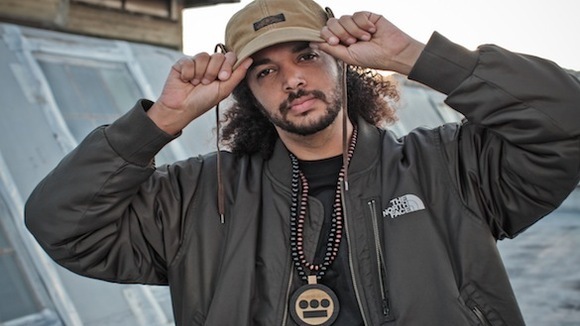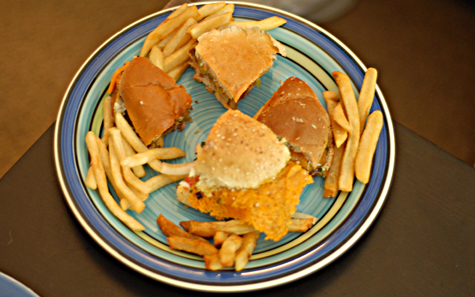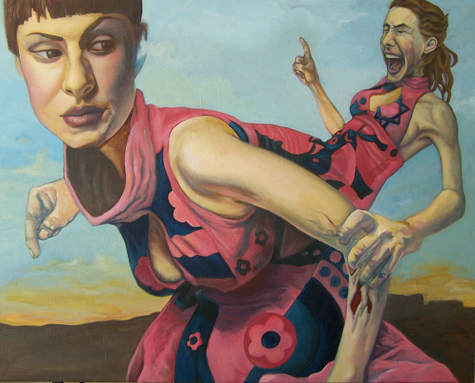More Real Than Reality
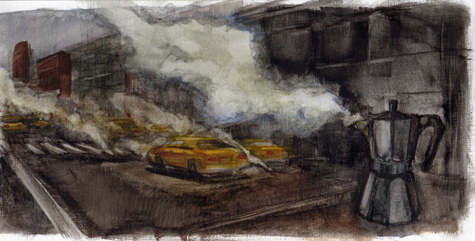
A slice of watermelon, a coffee pot, a steaming train; these things may mean nothing to you, but to the person on your left the same random objects could strike a nerve. In a good way.
When abstract/surreal artist Fernando Duarte had his first Sacramento art showing at The BrickHouse Art Gallery years ago, something extraordinary happened. One Oak Park woman was so touched by one of his paintings on display that she insisted on taking it home that evening. “She just had to take the painting that night,” remembers Duarte of the rare but welcomed occurrence.
“She experienced the same thing I experienced.” Duarte goes on to say, “She later sent me this letter that said, ‘Things happen for a reason.'”
As Duarte carefully pulls the hand-written letter out of a photo album and slowly handed it over he softly said, “That letter to me is more than anything people pay for art. That made me feel like sometimes art really touches people. When that kind of stuff happens, it’s amazing to me.”
Before heading to his current show entitled ABSURDA (an anagram of abstract, surreal and dada) at Inferno Gallery, Duarte graciously took some time out of his Second Saturday afternoon to speak with Submerge in his Midtown studio on topics ranging from “fast food art” to mocking reality.
Were you introduced to art at an early age?
I was born into a family of artists in South America. I am the youngest of seven; four of them are painters and artists. When I was 4 or 5 years old, I used to go to the art school with my brothers. I have no notion of anything else, I don’t know anything about accounting or medicine it was only art in my house. I had no choice; I had to become an artist.

Now that you’re a full-time artist, do you think of it as a regular job the way most people think of their jobs?
Yeah, it’s just like when you’re a monk or something, you cannot be an 8-to-5 monk [laughs]. I try to paint, draw and do prints daily. I go home, I sketch. If I’m at the studio, I sketch. Even if I travel, I sketch.
How did you come to settle in Sacramento after spending so much time in the Bay Area?
When I had kids somebody told me, “Davis is great.” Basically that was the first move years ago, back in ’80-something. I got divorced and moved back to the Bay Area but my kids were here, so they were the main reason to be in this area. Eventually I started working more in Sacramento and knowing more people. And when the economy is so crazy in San Francisco that not even the mayor can pay his own rent, they push you out: From San Francisco to Emeryville and from Emeryville to here. You pay per square foot [for a studio], so I told the guy, “Give me a square foot, I’ll do a 1-foot by 1-foot painting [laughs].” They brought in all the dot-comers and heavy industries. This is what happened everywhere I had been.
Back in ’05 you were quoted saying, “I see a lot of potential in the Midtown area.” Now that it has been a few years, what are your thoughts?
It’s amazing, it’s getting better and better. I think Second Saturday is a little bit cuckoo. It’s becoming what I call “fast food art.” But it’s good; at least it brings people out in the streets. What the people need to learn now is to divide the art, food and music. Sometimes people go into the galleries just like it’s a meat market for the wine and food and that’s it. Art becomes secondary. It still has great potential, though.
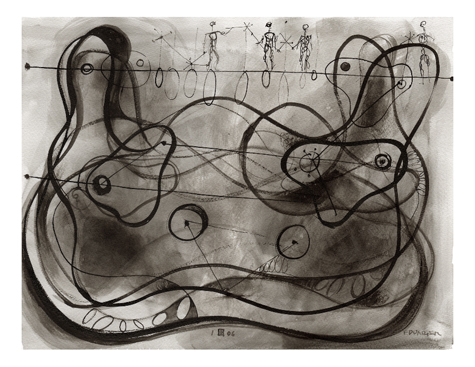
Is that why you had the ABSURDA reception before this Second Saturday, to avoid the crowds and the madness?
I did the opening last Friday because tonight I don’t think I will have time for buyers. People came from the Bay Area mostly, along with friends from Davis and friends from here. I like to be with them for one particular day without the whole crowd because I start to lose it. I don’t like openings anyways, but I do it because you have to do it. It becomes like a zoo, you’re like an animal in a cage and they analyze you and check your work. Now what they need to learn is to really understand art. People spend $200 eating sushi but won’t spend $300 on a print that will last forever. It’s an investment for yourself and for your future. Every time I sell something, I invest more than half of it back into art.
So you consider yourself an avid art collector then?
I have over 65 pieces. If I don’t do this stuff, who is going to do it? If you’re a musician, you buy music, you know? If I’m tight on money, I still buy art. It’s important.
I’m curious as to how you would explain your artwork to someone who had never seen it.
In words it’s hard to say. But I would say that it’s just mocking reality a little bit. I try to make a painting more real than reality sometimes, even if it doesn’t exist. I love the metaphysical or surreal point that you fake reality in a way. Reality can be anything but I like to play with the ambiguousness of reality and non-reality. You have to understand I was born in a town in a country where reality was so crazy. You can walk down the middle of the street and see a horse walking by.
When you’re painting are you thinking about how the piece is going to make people feel when they see it? If so, does that affect your work?
Yeah, sometimes when I’m painting I have this brainstorm in my head about everything, except money, honestly. I am even thinking about the person who is going to frame this work. I am thinking about how is it going to be looked at, how would it look upside down? What are the people going to think, what are they going to say? Painters forget about this, they become so involved with the painting, and that’s good but at the same time you have to think, “How are people going to react to this?” I’m not trying to please everyone and I’m not thinking about if it’s going to look good or bad in their living room, or if it’s going to look bad in their office. I don’t care about that. But I do care about feelings.

Getting to Know a Familiar Face
If you like hip-hop, you probably know this underground rapper/producer and probably don’t even realize it. As a result of 15 years of “forward-thinking” and hip-hoptimism with Souls of Mischief and Hieroglyphics, Oakland native Opio’s ’90s-esque collaborations have been emulated by the likes of Kanye West and Lupe Fiasco. Opio offered up some “vulture’s wisdom” and spoke to Submerge about his most recent solo project, hip-hop philosophy and his current tour that maked a stop in Sacramento.
There is something I wanted to clear up with you, Opio. You are a solo artist, but you’re also part of Souls of Mischief and Hieroglyphics?
Yeah, you know. Souls of Mischief been doing it professionally since signing a record deal in ’93. I was with them; that’s where I started. And then, Hieroglyphics has been out for 10 years”¦ It’s not like I’m a solo artist. I’m in Hieroglyphics. I’m just putting out these projects, solo projects. I’m more well known for being in Hiero and Souls of Mischief and I’ve been down with them groups since their inception.
There were some incredible things said about your talents from other magazines. A lot of people listen to your music; a lot of people know who you are.
At this stage, when I’ve been doing it for a while, it’s just a blessing to be able to do what you love. Like the press, it’s different for me, because people who are going to listen to me, I don’t think they are swayed really to hard by what’s hot and what’s not. There’s a connection that I have with people that I’ve learned over the years. Just being consistent with the music. Some people fall off the map and don’t stay consistent.
Your new album [Vulture’s Wisdom, Volume 1] came out July 15. It’s volume one of a trilogy and you’re going to try to get all three volumes out within a year. Are they already recorded? What’s the deal?
Volumes one and two are already done. Volume three, we don’t want to overstep our boundaries and make sure that we have something that we can feel we can manipulate and want to work on it. It takes a while. Volume one was done last October, so it’s been done for a while. Volume two was done at the same time. You don’t really want the music to get old and stale. With volume three, we’re still trying to tweak it out a little bit, just off of what people say. Volume one and two we did quickly. We just had a really good creative energy and the space that we were in was really cool. I’ve worked with Architect [producer] before. Our mentality is that we want to start more of a movement than just getting people into one or two songs.
You want to try and get them to like the whole trilogy?
We’re trying to change people’s ideas about how they listen to music. Like, instead of listening to songs or a single, or trying to listen to an album and skip through every single song on your first listen. Everybody is going to skip around once you had a CD for a while, because you’ve got your favorite songs. If you’re going to pop a CD in from an artist that you like, you should want to be able to sit down and listen to it. The artist has to give you what you need as well. You don’t want to have fast-forward material. But our mentality is we’re making albums, we’re not making hot songs or a hot single that everybody can jump on and be like, “Yo, this is the joint right here.” It’s more about the whole album—more so than the trilogy. We want people to get into the album as a whole. Listen to the record, sit with it. A whole solid listening experience”¦change people’s mentality in terms of how they’re listening, at least to us.
You said you want to change people’s perspectives. What does that have to do with the album title?
The title is just coming out of conversations that me and Architect had in terms of what we were seeing in hip-hop. If you ever hear people just really disgruntled, “Back in the days, it used to be so tight, and now it’s all commercialized. It doesn’t have the same energy it once had.” That’s what people say. To me, hip-hop is just powerful. It’s more powerful than it’s ever been. Even though maybe some people are just quick to have this real apathy toward hip-hop”¦ Me and Architect still have the vision and the wisdom to see where other people see nothing, we see sustenance. They done picked away at it and left this like skeleton. But, we can still swoop in with the “Vulture’s Wisdom.” We can eat and see food where others just see nothing.
This tour that you’re currently on, The Freshly Dipped tour, it’s the 10th anniversary tour of Hiero Imperium. You’re playing with Hieroglyphics as the headliner, but are you doing any of your solo project songs?
Yeah, definitely. My album is the album that’s out right now. It’s a good opportunity for me to promote myself. People know Souls of Mischief and Hieroglyphics, but they don’t necessarily know me. It’s an opportunity to raise these peoples’ awareness of what I’m doing. Because, a lot of the people that been listening to Hieroglyphics and Souls of Mischief over the years, they know me and they’re in touch with me and they like my style, but it’s just kind of hard if you’ve been doing it 15-something years, all they know is Souls of Mischief and Hieroglyphics, they don’t really know to say Opio.
Kasbah Lounge
2115 J St.| Sacramento
Deciding upon a worthy and not-too-frequented dining spot around central Sacramento that featured ethnic eats was no easy task. There were a lot of worthy and affordable international restaurants, but many only open until 3 p.m. or 5 p.m., or only open on the weekends for dinner. But truly desiring delicious Moroccan delights, I was stoked to find the Kasbah Lounge was open (every night from 5:30 p.m. until 3 a.m.), moderately priced and located at 21st and J streets in the Midtown “Kasbah” or older/vital neighborhood (generally in cities of Northern Africa).
If you’ve never been to Morocco, it’s a vacation spot for Europeans that is diverse and disorienting to the senses. Like Mexico to the vacay-ers of the U.S., venturers to Morocco are skeptical of food illness and un-bottled water. After my last four days spent in Morocco dining on spice-stewed meats, fluffy couscous and sweet mint tea, I spent three days dealing with food poisoning; which thus led to my one-year boycott of Moroccan food that ended with a worry-free dinner at Kasbah Lounge.
Although Kasbah Lounge’s Web site boasts Middle Eastern food, the restaurant/lounge/bar/hookah hook-up offers more of a mix between Mediterranean and North African food. Choosing to sit on benches with comfy decorative pillows and a billowy canopy of cloth, I reviewed the rustic rough-cut leather menus with crude copper fixtures holding food and beverage lists in place. I decided I had to have the $5 authentic mint tea and $12 lamb tagine. Thé de la menthe de Maroc is often referred to as “Moroccan Mint” in the U.S. and is usually very strong and very sweet. Tagine is a Moroccan dish, but also the pot the dish is cooked in. A tagine is a clay pot with a wide bottom bowl/dish with raised sides (much like a deep sauté pan) and a cone-shaped lid with a hole at the top to release steam. A tagine can be used on a stovetop or in the oven. The dish tagine usually involves combining large-cut seasonal veggies (zucchini, carrots, squash and potatoes), garbanzo beans, big pieces of meat (lamb, goat or chicken) and a lot of rich spices like cinnamon, cumin and coriander.
How did my food stack up? Well, since I’ve had the real thing, I could tell you that it wasn’t the most authentic Moroccan food. But, lucky for you, that means you’ll feel more comfortable eating it; and there’s no question about where it came from or if it will make you sick. As far as quality control goes, Kasbah Lounge used fresh, high quality products that ultimately made the experience surprising and satisfying.
However, the total package wasn’t cohesive. While my lamb was perfectly cooked and not at all gamey (tends to happen with lamb), there weren’t enough veggies, the sauce was thick and gravy-like, there was too much cinnamon on the plate and the portion of couscous was very small. Regular small grain couscous should’ve accompanied this dish, but came with larger Israeli couscous that tasted like it was warmed in some type of stale animal fat. You can imagine my surprise when receiving a dish twice as heavy as expected. But the food was hot, good, very flavorful and delicious and was served with freshly grilled pita bread (although I think it wasn’t made fresh).
The mint tea was served beautifully in a metal pot with little, whimsically shaped glasses; but the flavor and preparation basically sucked. There was little straining of the leaves and no instruction was given on steeping time. At first the tea was too watery, then it was too medicinal tasting. Plus at $5 per person, the tea was expensive and should have been better; especially for a place that claims they’ve got the “best mint tea in Sacramento.”
I would definitely go to Kasbah Lounge again. The vibrant colors and attention to decoration detail create an invigorating ambiance. But, I would make sure it was at a time when I was looking for a lighter, whimsical dining experience. If you’re super hungry and/or looking for early bird specials or value meals, this isn’t the place for you. But there is a weeknight happy hour from 5 p.m. to 7 p.m. I’ve marked my calendar to try out the happy hour deals like the $3 pints of sangria and the $2 or $3 appetizers. Think of this place as a great starter for a night out or a destination experience with good friends.
Words by Josselin Basaldu
I’ve been waiting weeks for this one, often fighting cravings in fear of burning out on America’s crown jewel of ground beef and its accompanying deep fried golden strands of starch. Yes, friends, I’m talking about the cheeseburger and freedom fries. Say what you will, but few meals beat the comfort and subsequent comatose of a fat greasy burger and crispy fries. And now that I’ve planted a seed in your subconscious cravings, let me now give you the only successful plan of attack: four great burger spots in the greater Downtown area.
Mind you it wouldn’t be fair to try just one, so instead I enlisted a team of Submerge staffers to help make the call and most importantly finish the food. Hunger overcame creativity, and thus was born the glorious challenge dubbed “Burger-Off.”
We tried to make the playing field as even as possible, so we decided to try each restaurant at the most basic level with the cheeseburger/fries combination. With that established, we created a complex rating system that involved tasting and thinking.
First off, the contenders: Located on 816 12th St., and with over 74 years of experience, our first spot is Jim Denny’s, a classic All-American burger joint.
For our second contender, located at 1948 Sutterville Rd. we chose Ford’s Real Hamburger, with an emphasis on the real.
The third contender, nestled at 7918 Fruitridge Rd., is the Squeeze Inn, which boasts over three decades of hamburger excellence.
And last but not least, located at 1630 J St., we have a local downtown favorite: Hamburger Patties.
Four heavyweights, three hungry judges. Let’s get it on.
Jim Denny’s
James Barone: Loved the thin, fast food-style fries—not as plastic-y tasting as the shit you’ll get at McDonald’s. Grilled onions on the burger were a plus, flavorful patty, but the bun was pretty weak.
James Pitner: Strong mustard flavor, quality meat, good cheese and grilled onions. The grilled onions made this burger.
Corey Bloom: The patty and fries were a little thin for my liking, but the flavors are good. A good burger, not a great one.
Ford’s Real Hamburger
James Barone: Biggest patty by far, but not as well seasoned as the other entrants. Tasty onions and fresh-tasting fixings, but the fries were also pretty boring.
James Pitner: This one comes with a cool layer of shredded lettuce and fresh fixings. I think they could have been a little more liberal with the seasoning.
Corey Bloom: I like a homemade patty, and this is definitely one of those. Very big and juicy, great bun and a good secret sauce. I remember them having different fries, which I liked better; but again, not bad.
Squeeze Inn
James Barone: Delicious hamburger patty and toppings plus a sesame seed bun all made for a great sandwich, but the copious melted cheese and cheese flap were a bit much—too salty
and distracting.
James Pitner: This burger is not for the weak hearted. The bun is delicious, the fixings handle their biz and the place is greasy as hell!
Corey Bloom: Great fresh, hand-cut, unfrozen fries. The cheese skirt that draped the burger was a little much for me, but once you get past that the rest is great.
Hamburger Patties
Corey Bloom: A good burger, and the most straightforward of the bunch. The fries were okay as well.
James Barone: Tastiest hamburger patty for sure, though the fries were pretty bland.
James Pitner: The charbroiled taste of this burger set it apart from its competition.
In the end, it was the Squeeze Inn who took it all, winning unanimously in the fries category and tied Hamburger Patties in the meat department. Propelled by great fries, their overall victory was an upset and a surprise to some (mainly me). However, as much as we tried to make it a competition, everyone agreed that all of the burgers were good in their own right and we would undoubtedly eat at each spot again.
Never Settle
Ask Kevin Lee, lead singer of Silver Darling, about the band’s fast acclaim and he will tell you quite simply that it was unexpected. With their first full-length, Your Ghost Fits My Skin, released on Crossbill Records this month, Silver Darling has quickly become a popular band in Sacramento. With their natural ability to create powerful, soulful music along with Kevin Lee’s weary, intoxicating vocals, Your Ghost Fits My Skin has become a highly anticipated release. Though it was just a project that simply started out as two roommates playing guitar together, the band has progressed into a three piece whose musical diversity has allowed them to redefine the folk genre. Submerge recently spoke to Kevin about the band’s influences, plans and the new album.
How did Silver Darling begin?
Josh Ahlansberg and I were roommates when I first moved to Sacramento, and I was just learning guitar. It kind of just developed from there. It’s been a really natural progression the last couple of years. Our friend Jesse Phillips started playing with us. There was definitely a time, about two years ago when we started a more intense practice schedule. We just asked ourselves if we really wanted to do this, if we wanted to commit to it and we did.
Sacramento seems to have embraced you guys pretty quickly. You have such a solid fan base already.
A lot of people who come out to shows are our friends. I think more people are starting to come out. It still feels like it’s the beginning. We are just getting people together and playing music. Sacramento has been great to us. We love to play in Sacramento when there are places to play.
What’s your favorite venue to play in Sacramento?
A house. Our best shows have been at houses. We are playing at Harlow’s for the CD release show. We’re looking forward to that because it has such a great sound system. It’s unfortunate because even though house shows are fun and it provides so much, after a while you start feeling the music itself is degraded a bit. Sometimes it’s really appropriate and the party atmosphere is awesome, but when you listen in a really excellent sound room”¦ Some places are just designed to hear music. I wish there were more places like that here in Sacramento.
You recently won an award for best male vocalist in Sacramento. How did that feel to get such an award?
It was really unexpected. I think, any embrace that has happened, has happened quickly. I was really surprised by it. It was an honor, of course, just surprising. I just didn’t think we were on the radar out in Sacramento yet.
You list influences from Neil Young to The Roots on your Web page. It seems you guys have a diverse range of musical artists that you look up to.
As far as the diversity, I think it comes from people who just put everything into their music. Just taking Neil Young and The Roots as an example—to me, those are people that really put themselves completely into their music. I feel like The Roots and Neil Young never settle and they only put forth their best music. They are always working on something. They are those performers who you can just tell that they put everything into their music. Bill Withers is also another huge influence. Every single thing he made came from such a real place.
Your album, Your Ghost Fits My Skin is being released on Crossbill Records. How did your relationship with Crossbill come about?
Well, we absolutely adore working with Crossbill. I can’t imagine a better working relationship. When we first started out, we were looking for people with that same passion for music, and we sent Mike Leahy a message and asked him if he had any openings on his radio show in Davis. We went and played on the show and put a couple more shows together with him at the Cool Cat Gallery with The Cave Singers. It kind of developed from there and he called us up and said that he would like to do what he could to put out our first album. It’s just a beautiful working relationship. Mike is our friend. To have someone on a label that we can call anytime is a lot more than what most people get, so it’s wonderful.
Where did you record the album, and how long was the recording process?
We recorded at the Hangar. We had plans to record at some other places in order to get really into the atmosphere where we were recording—off onto the country and whatnot. But as soon as we started working with Christian Kiefer, it just became obvious that it was not going to be feasible. We were not going to be able to bring out pianos and pump organs to a barn you know? It was becoming too big. We booked four days at the Hangar and we just practiced a lot. The Hangar is amazing and we can’t imagine now not recording at the Hangar.
You finished recording the entire album in four days?
We recorded the whole album in three days and started post-production on the last day. Kiefer also worked for about three days by himself on the mixing and the editing.
For new listeners who may not have heard the album yet, how would you describe it?
It’s the album that we definitely wanted to make. I think there are elements of folk, country and bluegrass. I also think there are singer/songwriter techniques. It’s a moody album but it’s not a storytelling album. It describes life experiences but not in a typical storytelling way. Rather, it describes more of how those experiences felt instead of explaining what actually happened. A lot of the songs don’t really bother getting to the results of what’s going on, just the moment of what’s happening.
That’s a really interesting approach to songwriting”¦revealing more of the emotional aspect of the experience rather than the actual experience. The title of the album is really interesting as well. Do you mind explaining it or would you rather not?
No, of course. I think Your Ghost Fits My Skin talks about the real stuff, about what’s really happening in life. I think it talks about the potential of people and the potential for life.
As a songwriter, do you feel that your life experiences makes up most of your lyrical content?
I tend to focus more on the heavier aspects of life. There are different phases throughout this album. I am influenced by things my friends are going through, and what I am going through. At first listen to this album I think there is a lot of darkness, but I try to inject a lot of hope and excitement over change. The second song on the album addresses that straightforward…that moment of change. The point where you are missing where you were but you are walking toward something better. I mean, those are the best moments in life for sure.
What are your plans for the band?
We are releasing the album and playing three different CD release shows. We are having all the musicians that played on the album play with us for those shows, so we are going to have a lot of people on stage. Then we are going to be going up to Arcata and probably going to Seattle and back at the beginning of the year. We are going to plan more shows. We are already starting to work on the next album as well. We are definitely just going to keep on going.
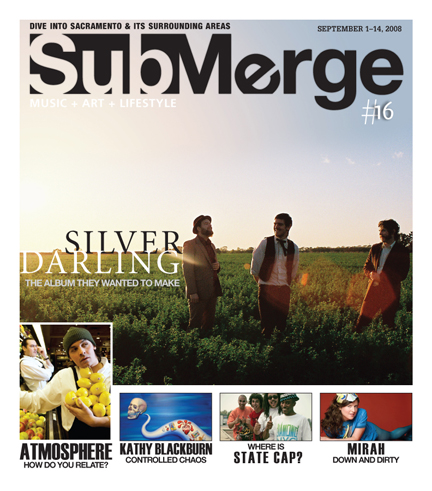
Pressure Point Celebrates Sweet 15
This year, Sacramento’s own street punk/Oi! prodigies Pressure Point will celebrate their 15th anniversary. An impressive feat in its own right—especially considering the tumultuous nature of the punk rock scene—what makes Pressure Point’s quinceañera even more notable is that they’ve managed to survive on their own terms. Though Pressure Point has shared stages with punk rock giants such as Rancid (Lars Frederiksen acted as their producer on two full-length albums and a 7-inch) the band has managed to survive, and thrive, in what lead singer/cofounder Mike Erickson calls an “underground within the underground.” To commemorate their 15th birthday, Pressure Point will release on Sept. 30 Get it Right, an anthology that re-imagines some of the group’s earlier material and includes a few new songs and covers. Before heading out on a tour that would take them to the Midwest and back, Mike met with Submerge to discuss the new release and the difficulties in bridging punk rock’s generation gap.
You’re heading out on tour pretty soon. Do you want to talk about that a little bit? Is it to promote the new album?
Sure. Honestly, one of the biggest reasons that I like to be in a band is that I get to travel, and it’s an unconventional way to see America. I see America through the eyes of people like me. It’s not a tour guide or a travel agent. I get to see this country through the eyes of people who are similar to me, who I enjoy being around, and have similar beliefs and philosophies. We’re not only touring to promote the record, but you know, it’s summer time. It’s a good excuse to get out and be with your friends and have a good time.

How have you seen the country change in the time you’ve been touring with Pressure Point?
In terms of the punk scene, the scene that I’m a part of, things have changed drastically since we started. There are still people like”¦Anti-Heroes and Agnostic Front—people that we met real early on who are still out there doing it and have the same beliefs and the same attitudes. But what I saw, with really good bands like Rancid—who were able to break through and bring what I consider legitimate punk rock to the masses—the aftermath of that was that every label wanted to get their own Rancid. They wanted to make even more money. They would get their carbon copies. They wanted to dumb them down. They would water them down, sweeten them up, so they could be more mass-produced. And there were some bands that were willing to play ball. When those bands did that, it watered down the punk scene at large and began to split it.
With the latest release, you guys are revisiting older material. What was that like for you guys?
A lot of the material was written by Kenny [guitar] and I really early on. When we started this band, we struggled to find the right fit with the different members because of the style we played. The approach we had and the type of politics we had were all really unconventional, and to be honest, kind of dangerous for this town. There weren’t a lot of promoters or record labels that were willing to work with us, and that was true all over the country. Pretty soon, we were able to connect and hook up and an underground within the underground developed. Because of all that, we always heard the songs a certain way when we wrote them, in our minds’ ear, but it never really came out on tape like we wanted them to. Over the years, we’ve had good friends and good band members and we’ve got the Nates [Hat and Mohawk, bass and drums respectively]. We’re turning 15 years old this year, and we wanted to celebrate that, so we went and revisited a lot of material, and now we were able to update it, refresh it and record it so it sounded the way we originally heard it.

Other than rerecording the songs, did you revamp them in any way?
That was a debate within the band. We decided that we were going to do the things we needed to do to make the songs better. Lyrically, I decided I’d leave the songs alone. There were a lot of lyrics that were really naïve when I wrote them. I wrote some of those songs in my early 20s, but I decided that they capture a time and a place and that I should just leave them alone. Musically, we altered and changed some of the songs.
Before you mentioned the songs you were doing were dangerous for the area. What did you mean by that?
Sacramento in the mid-’90s, the punk scene was kind of smoldering. It was suffering from a lot of things left over from the ’80s. Within the scene in the late ’80s, early ’90s, there were a lot of Nazi skinheads that were left over, and they were threatening the entire punk scene at large, so you had that violence and that danger, and then you had on the other side of it people like Kenny, people like me, who grew up in Sacramento lived in Sacramento, lived through that, and were battling, of course, against those kinds of notions. So for us being a straight up Oi! band, a street-punk band, a band that espoused a skinhead philosophy and attitude—of course a traditional one—a lot of promoters around here got scared. A lot of them said, “Oh, I don’t want that.” We were never ones to look at the problem and just sweep it under the rug. We confronted it head-on, recognized it and dealt with it. They were afraid there would be trouble at gigs, that if they put us on bills, it would draw them [Nazi skinheads] to shows. These guys were coming to shows anyway. We did our own shows, and now we have our own scene. It’s fresh and vibrant. We don’t have those same problems, we don’t have those same issues, and over the years, we were able to hook up with a lot of national acts that were really getting big, and if it wasn’t for them demanding that we get on bills, a lot of the promoters around here would not work with us.

For the new songs you wrote, could you talk about those lyrically?
One of the new songs on the record is “Fuck the Kids,” and it’s a hardcore song in the tradition of New York style or early ’80s style. The American landscape early on, there weren’t many divisions. When we went to shows, you’d have Reagan Youth playing with Bad Brains playing with Sick of It All playing with Gorilla Biscuits. So you’d have straight edge bands playing with skinhead hardcore bands playing with more leftist punk bands. Everyone had a lot of respect for each other and just did their thing.
It seems that over the last 10 years, especially the last five, there’s been a lot of sectioning off and divisions within the scenes at large. I noticed that as a skinhead that me and a lot of my punk rock friends would go to hardcore shows, because we really appreciate that kind of music, and the kids would shun us like we didn’t belong there because we didn’t look like them. And that with the infusion of metal made it so that it wasn’t really connecting with where it came from or where it was”¦or what it is.
I wrote a song called “Fuck the Kids” and Kevin Seconds from 7 Seconds sang on it. I asked him because they were pioneers of the original West Coast hardcore movement, which had more of a positive vibe, bringing people together. Even though we’re not a posi band, we have a similar attitude. It’s about taking people who are outside of mainstream society, or the people who at least don’t fit necessarily. They don’t want to fit”¦they would find their way in this other scene at large as individuals, and that seems to be lost. There seems to be a lot of conformity, a lot of packaging, a lot of formulaic nonsense within the hardcore scene, and it happened in the scene of music we play, too, in the late ’90s, and I think in a lot of ways that’s what killed it. And whenever you lose that identity, you lose that ability to sound original or to be original or to think on your own, then you lose touch with where you came from, and that’s why I wrote “Fuck the Kids.”
Why do you think that the fractioning of the scene has happened?
I think it’s largely people like me who are to blame for that. I’m 38, and I don’t think people my age were as vigilant as they should have been, or maybe in some cases as welcoming as they should have been to the new generation. I also think that, again, hardcore broke and record labels were like, “Oh, package it, sell it, it’s all about money,” so you had a lot of bands that sounded the same, and a lot of kids glommed on to it. The attitude became more of a mob mentality as opposed to a punk mentality. When I overhear people who are into hardcore—and I’ve overheard them telling Kevin Seconds that 7 Seconds isn’t a hardcore band—that’s the attitude right there that I’m talking about.

Local Artist Eli Trujillo Mixes it Up on the Palette
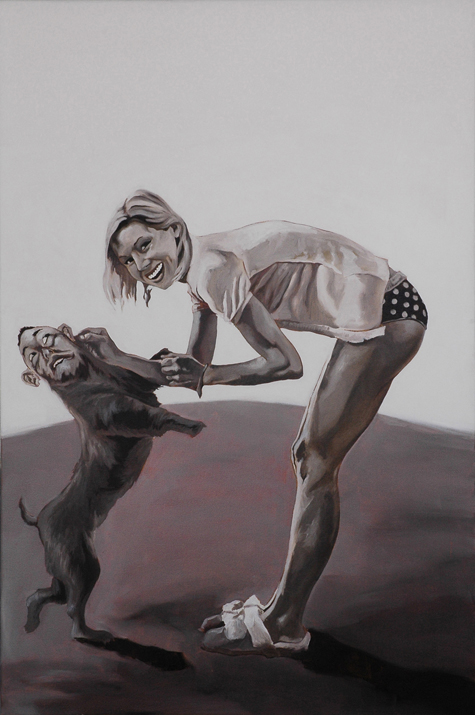
A beautiful blonde plays with her dog in the park—wait, does that dog have a human face? A young couple takes in an art gallery pose for the camera—hold on, looks like the boyfriend has morphed into a gargoyle! Enter the colorful and sometimes bizarre world of local artist Eli Trujillo. Most of his paintings begin with a real person in mind, either a friend or family member, or perhaps a recent celebrity infatuation; but when the genius begins, Trujillo starts making changes.
He describes his sometimes funny, sometimes serious twists on real people as “not exactly a remix; more like a cover toon.” Growing up on a diet of comic books, Trujillo cites comic book painter Simon Bisley as the artist who sparked his interest in painting. Add the influence of Norwegian figurative painter Odd Nerdrum, and what emerges are unlikely portraits that morph ordinary humans into two-headed women, dogs with human heads and bug-eyed cartoon beauties.
“One of the major things that comic books did was give me a strange idea of what humans should look like, as far as guys being super buff, having six packs and being able to punch through walls,” Trujillo said.
Unfortunately, the real-life Trujillo does not possess superhuman strength, and spent many years working regular jobs, including a brief stint blending Caramel Machiattos at Starbucks, which he quit after watching Fight Club too many times.
“I just started hearing about consumerism and the corporate world. I was going to try and do with less and see if I could make it not working,” Trujillo explains.
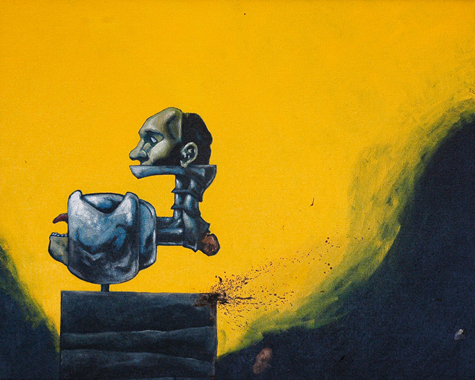
His days of corporate freedom lasted two glorious weeks; then, it was back to the daily grind and another mindless job. Eventually, though, the small boy that used to draw cartoons spoke up, and he began to take his art more seriously. In 2007, Trujillo quit another job to pursue a degree in Art Studio at California State University, Sacramento.
Since moving to Sacramento in 2004, Trujillo’s work has been shown mostly in smaller, more alternative art spaces like Greg Pond Photography in 2006 and Studio Yes in 2007, as well as A Bitchin’ Space in 2007 and the Brick House Gallery in 2008.
Beginning Sept. 13, Trujillo’s paintings will be part of a circus-themed group show at A Bitchin’ Space. The various paintings will make up a circus train, but it’s doubtful that Barnum & Bailey would approve. This show is “a protest for animal cruelty,” Trujillo says. And don’t expect participating artists to spoon-feed their message to the public. Trujillo explains that it’s up to local Sacramentans to decipher their protest message: “We tell people it’s just a circus show,” he said.
Although Trujillo’s paintings pack a powerful (and colorful) punch, most aren’t intended to make a statement.
“I’m just letting people know what’s going on in my head,” he said. Movie buff and self-proclaimed junk—TV watcher, many of his paintings highlight celebrities.
“It’s interesting that you can get infatuated with people that you don’t know,” he said. “Most recently, I have been working with the ideas of celebrity worship, idealism and the unreasonable expectations they create. In conjunction with these works, I am beginning to use photos from my family archive in the same manner, creating an interesting juxtaposition when shown together.”
Trujillo also creates what he calls “personal propaganda” pieces, which serve as good advice—directed toward himself. For example, he’ll paint a picture of himself with no shirt on.
“I’ve got a nice gut going on. [The pictures] make me not want to eat ice cream so much,” he laughed.
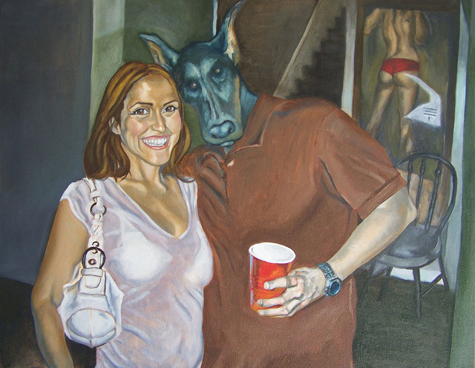
Trujillo says that these paintings are meant mostly for himself, but it’s quite possible that others could learn from them as well.
“Almost all my paintings are personal and autobiographical, so I think it’s hard for people to really get a hold of them,” he said.
Formal instruction in art has greatly improved his ability with techniques like space and volume, and he’s noticed that his paintings have become increasingly more realistic as his skills improve.
“I’ve recently been making a conscious effort to place the figures in an environment rather than, say, a red or gray background, to create a more believable space,” he explained. Looking back on work that was completed in the past, he notes that some paintings are much more juvenile than others, and oftentimes he’ll change or alter these paintings. “Something I’ve just started doing is not being afraid to change things”¦even two years after its finished,” he says.
On the other hand, though, he hasn’t lost his love for goofy-looking superheroes. “Although I take my paintings seriously, I also try and inject a bit of humor into them. I would love to see someone fall over laughing at one of my works, but this has yet to happen.”
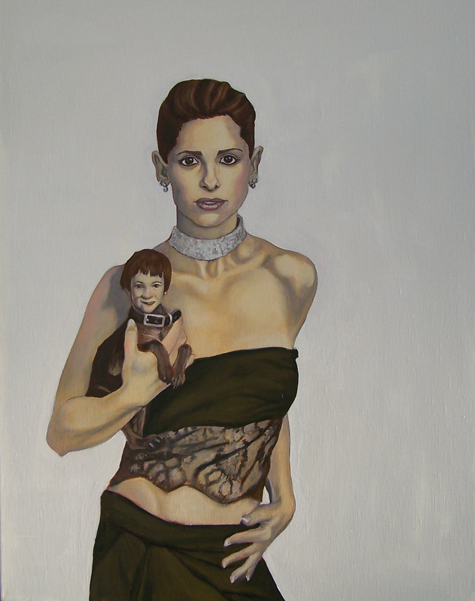
I must be certifiably insane. To some this may not be a revelation; in fact, admitting it has been a long time coming. How do I know I’m insane? There have been signs in the past: attachment issues, light compulsiveness, depression, self-abuse”¦ But in the end, it took three years of law school to sober me up to the truth: “Hi, my name is Bocephus Chigger, and I am a lunatic.”
To put it simply, no sane person would go to law school. My daily workload went from nothing to 60 hours-a-week. I mean, I like to read and write, but that shit is ridiculous. Add to that the anxiety of getting called on in class to explain one of the 10 cases you read last night. Now, multiply that by 100 for each person in class adding to the mix and feeding off it and, voilà: Law school! Sure, it gets a little easier as you go, but it’s just a tease. They just need time to finish the barrel you are about to be bent over, more commonly known as the California Bar Exam.
Ah, the Bar Exam”¦ The legal community’s way of saying, “This isn’t over yet.” The party starts right after law school actually finishes. By this point, you have already paid around $5,000 for BarBri courses and administrative fees. Thankfully, you can take a loan out to cover it and make the rest of your $150,000-plus debt just a little cozier. In exchange, you get to wake up early to go park your ass in the most uncomfortable chair in the world, all while listening to someone try to reteach you everything you have forgotten over the last three years. This is your life for the next 10 weeks.
When Day 1 of the exam hits, you are ready to pop. Thankfully, the examiners make this situation easier on you by having more arbitrary rules than the FAA. I don’t know what I was thinking trying to bring a plastic Safeway bag in there. I guess I will have to wait until after the test to suffocate myself (thanks, Bar Association!). I was also glad to see the only source of drinking water allowed in the room was a half-mile walk away. There is no better way to pass a timed test than by wasting five minutes to have a glass of water.
Day 2 features 200 multiple choice questions that you have six hours to complete. Not only is this mind-numbingly boring, but reading 200 fact patterns in six hours melts your brain. After exam day ends, exhaustion, hunger and inability to hold a conversation all kick in. Enjoy the night off in your semi-retarded state, because tomorrow you get to wake up early and do it all over again”¦only this time, you get to write essays all day!
At 5 p.m. on the third day, the proctor calls time. Huzzah! We are finished! As if by magic, alcohol appears in your hand. In one smooth motion it makes its way into your blood stream and up to your brain. Let the drunken wandering begin! If you are like me, you may end up hollering at a lovely woman named Erin while she is on a date with a guy she met on Match.com. After giving up on that one, you have your favorite bi-weekly free magazine hook you up with some tickets to the Ghostface Killah show so you can see the God bless the mic in person. Of course after the show, it’s time to start drinking again. Before you know it, it’s 4 a.m. and you have been up since 6 a.m. the day before.
Now do you see? Only an insane person would voluntarily do this to themselves. And yet, somehow, I survived. Pushing yourself to the limit can be a valuable learning experience, but I don’t recommend the Bar Exam as your vehicle of choice. You don’t want to catch the same crazy I did. Now, if you need me, I will be on a corner in downtown Sac begging for change to pay off my loans.
– Bocephus Chigger
bocephus@submergemag.com
!!! Wants You to Slam
When the collective runoff of ballyhooed Sacramento bands Black Licorice and Popesmashers joined forces after a mid-’90s tour, they probably didn’t realize their labor would yield the seeds for the forbidden fruit of dance-punk. They probably didn’t even realize that what they were doing was all that unique. But however you slice it, the niche-malleable !!! (yes, you can pronounce it in any number of thrice repeated bursts of syllables—most commonly Chk Chk Chk, but don’t forget Pow Pow Pow, Bam Bam Bam or any other such triadic inference) introduced to the fringe-stream a hypnotic freak beat mythos that spawned more bastard-children experimentalists than had Wilt Chamberlain studied Blondie rather than basketball. Their symbiotic mastery of marrying organic jams into heady blips of post-punk funk has afforded them opening slots on major tours (2006’s opening slot in support of Red Hot Chili Peppers in the UK), and has paved the way for the moderate successes of their last two studio albums: 2004’s Louden Up Now and 2007’s acid-punk/funk field guide Myth Takes. The band is currently on a brief West Coast tour, slowly wrangling their brigade from various corners of the country to once again coalesce and steer the vessel even deeper into uncharted waters, or as guitarist Mario Andreoni alluded to Submerge, to blindly forge straight into the dock. Either way, bring a life vest and some deck-safe dancing shoes.
!!! has its foot planted nowhere specific musically. How liberating as an artist is it for you to not feel pressure to homogenize your craft to fit into a niche?
Well, we do tend to work on things that have a strong rhythmic foundation so”¦ From there, it’s pretty wide open though. I don’t worry too much about the rest.
The indefinable aspects of your music often surface as the focal point of it as well; abstracts become hooks, dissonance becomes harmony. Are you ever concerned that by way of the indefinability of your music that your songwriting is guided toward that indefinability rather than emerging from an organic jam?
If part of me was concerned about that, I’d want the other collective parts of me to punch that part in the face.
Being one of the forbearers of the progressive dance/funk scene, what trends do you see infiltrating the mix that you guys are really into? Which trends are you seeing that you think are detrimental?
Being a fan of lots of old obscure/odd/forgotten dance tunes, I tend to really like freaky re-edits—creative DJs or producers reinterpreting songs, making them longer, adding bits. What I dislike, though, still comes down quality. I want a good tune. Subjective, I know, but I don’t keep up on what [the] latest things [are] in any musical genre—sort of blissfully unaware.
Is the band still spread out across the country? And if so, how is your chemistry affected when you reconvene for small tours like the one you’re on now, or when you get back together to create music?
Yeah, most of the guys live in Brooklyn while Allan [Wilson, horns, percussion] and I live on the West Coast. We toured most of last year and that probably had more of an affect on our chemistry than the separation ever did. I’m frankly used to [the separation], although it’s certainly not the easiest way to make music as a band.
In what ways do you feel making an artistic statement with your music is important? How does that stack up against playing music just because you enjoy it? And where do those two roads cross paths for !!!?
When creating, I don’t make the distinction. If we’re working on a tune and it makes me smile, gives me goose bumps or some other crazy feeling, I go with it.
What are the band’s plans for a new album?
Working on new tunes now. Ideally, I’d like to have most of it recorded by end of this year, but we’ll see. It’s still early in the process. The goal is to keep making better records, which I think we’ve done. I’m sure it’ll slam though.
In what ways has the Sacramento music scene changed since you guys began playing?
!!! came out of a pretty tight downtown community. Once that “ended,” I’m not sure who picked up the torch. I sure hope there is some weird small scene brewing in Loomis, or Rancho, or Folsom”¦doing more than just anger-rock that is, which seems to be a pre-requisite to getting any “pro” rehearsal slot—in just about any city. People outside of Sacto always wonder about what was going on around the time we formed; it was really great to be around so many smart, supportive and open-minded music snobs.
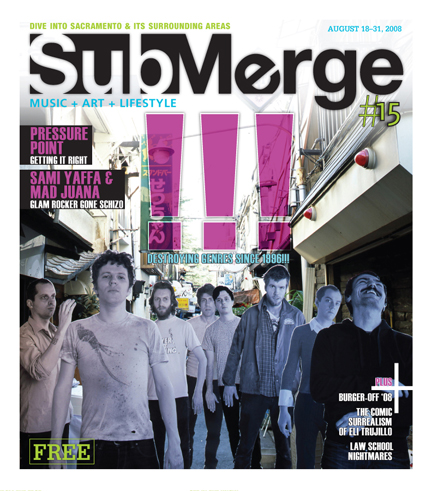
Jamie’s Bar and Grill
427 Broadway Sacramento, California
You could drive past Jamie’s Bar and Grill 100 times without realizing it was even there. Located at 427 Broadway, Jamie’s is not extravagant by any stretch of the word. Other than a green awning there isn’t a sign that would attract the eye, and without the large concentration of cars surrounding a vacant lot, I probably could pass it fully knowing where I was going.
Some people might look at the bland exterior and be turned off, but for me this is a great sign. I’m a simple man, and all I need is good food.
I had heard tales of Jamie’s for a while now, but always from the middle age professionals not my peers. Open Monday through Friday from 11 a.m.-2 p.m. and then from 5:30 p.m.-8:30 p.m., which explains the latter. On the Wednesday afternoon, I made it out to the place, and it was filled with khakis and collared shirts. I was definitely the youngest person in there by 15 years. The bar (to eat no doubt) was completely filled and a line of a few others waited for their turns. I was immediately seated and taken care of from the start. Off the bat, I was immediately at home in the dimly light restaurant of maybe 20 tables. There weren’t any windows so light was minimal, and the huge mounted Bison head really ties the room together. It was easily recognized that most of the clientèle were regulars, which is always a testament to a restaurant’s food.
Their menu was one page and very straight forward. I had heard good things about their burger and steak sandwich, but it all sounded good to me. All the menu items were sandwiches of some sort, with a few salad options and some specials, which mostly consisted of sea food, but the $15 price tag sounded like they were more of a dinner thing. All sandwiches came with a choice of fries, onion rings or salad and were mostly in the $7-9 range.
After much debate over the hot turkey sandwich, which came with mash potatoes and gravy, I sided with “Jamie’s Club.” It sounds a little boring I suppose, but the food was far from that. Obviously catering to the lunch crowd, the food came relatively quick. Served on a large plate, the entire surface was covered with thinly cut and crispy (and flakey but not over cooked, which is good!) fries and a monstrous sandwich. Between lightly toasted slices of fresh sourdough they managed to fit avocado, tomato, lettuce, chunks of white turkey meat and recently cooked bacon. It was impossible to taste it all with one bite, so I had to plan my bites accordingly”¦or maybe I’m just weird like that.
So many things made the sandwich great, but the turkey was the stand out flavor. Carved straight from the carcass, the meat was moist and cut in thick slices. They definitely weren’t shy with the portions either, which was greatly appreciated. Aside from the turkey, and again I’m a simple man, but the tomato was peppered. This might not sound like a big deal, but it added a distinct taste. And more than that, it showed that they were actually mindful of what they were doing and not just mindlessly throwing stuff on bread. The bacon was greasy and hot, not heat lamp hot, and did what bacon always does: make whatever you’re eating that much better.
They had me before I walked in, and the food was everything I had imagined it would be; simple and awesome, with quality ingredients and hearty portions. I will be undoubtedly be going back to Jamie’s on a regular basis, and just may have a new place to eat/drink before a River Cats game.





